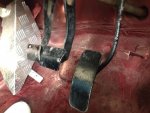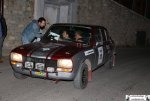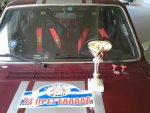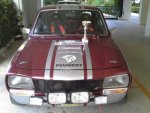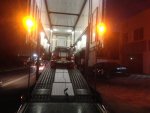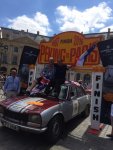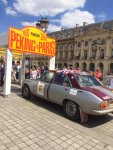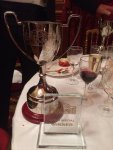- Joined
- Aug 2, 2000
- Messages
- 11,485
As soon as the Mercedes team ran out of pace notes, in Malaysia, Dunkerton was quickest.
Getting his own back Watson was quickest in the Victorian Alps it was agreed he wouldd drive those stages as he knew them well and Dunkerton blitzed the field at Warri Gate only for the stage to be cancelled when the official left early!
Other stages in Australia were won by the Mercedes as they had people stationed to open and close gates for them!
They fitted the 4.6 diff to the 504 for Australia which made a big difference.
The car was turboed for 1979 and Bob Watson won a Victorian Championship event, then got the V6 turbo for 1980 and 1981, ultra fast but a bit daunting to drive according to Bob .
I still have the build sheets.
Getting his own back Watson was quickest in the Victorian Alps it was agreed he wouldd drive those stages as he knew them well and Dunkerton blitzed the field at Warri Gate only for the stage to be cancelled when the official left early!
Other stages in Australia were won by the Mercedes as they had people stationed to open and close gates for them!
They fitted the 4.6 diff to the 504 for Australia which made a big difference.
The car was turboed for 1979 and Bob Watson won a Victorian Championship event, then got the V6 turbo for 1980 and 1981, ultra fast but a bit daunting to drive according to Bob .
I still have the build sheets.
For sure, Graham; I was referring to Stathatos' 504, which he described as slow. He also described some of the questionable tactics by Zasada and the Mercedes works team as an indication of what it took to be fast in that event.
Do you still have it? The factory sheet also indicates standard Ti engines (they picked the more powerful ones from the litter), although they used Safari spec suspension and many other Safari parts.
The following listing is from the Sochaux factory and includes period [1976?] pricing. I have tabulated the items to read more easily.
Rally car preparation
The 504 Ti is considered as the most suit*able version to form the basis on which to develop a marathon rally car. The engine in standard form develops 106 bhp maximum, using the well proven Kugelfischer fuel injection which has showed itself to be a most reliable system in service.
The factory at Sochaux has made special provision for the preparation of the bodies to rally requirements. This takes the form of additional fabrication in specific areas, eg roll cage reinforcements, wing valances in thicker steel, double skinned front members, extra welding, etc. The lead time for this preparation in normally in the region of three months. Such work can be carried out for any serious competitor and the whole package will include the following:
1. Reinforced body
2. Selected engine from production capable of around 110 bhp
3. Differential from carburettor version (9 x35 in place of 9 x 34)
4. Reinforced suspension (standard African spec.)
Total cost: FF 10,000 plus price of the standard Ti model.
In addition to the basic unit, further items are available, listed as follows. We can also provide a good deal of other information and suggestions which have been developed from our highly successful works competition team.
This total package will provide any rally team with a very competitive vehicle, capable of long distance durability and proven reliability.
Reinforced for rallying FF £ 2 front suspension legs 2,700 ea 349.41 ea Rear shock absorbers 1,366ea 176.71 ea Rear springs 270 ea 34.94 ea Special steering rack (PAS type, smaller turning circle) LHD only 1,270 164.35 Clutch disk (metal type) 725 93.75 Hypoid Diff with limited slip (ratio 8 x 37 + 170 kph @ 7,000 rpm) 2,700 349.41 Engine and gearbox protector 1,790 231.65 Diff protector 1,350 174.71 Gearbox - close ratio 13,000 1,682.35 Safety fuel tank (100 litre) 3,500 452.94 Roll cage - Devil ? ?
Other items which are modified or adapted:
· Straight through exhaust system manufactured by Chretien
· Special uprated engine mounts and stabilizer bars
· Guard for the clutch slave cylinder
· Radiator repositioned 15mm forwards
· Rear bump stops moved to act on the middle of the rear suspension arms
· Rear cross member completely locked up
· Special rapid-fill tube for the gearbox
· Internal control for the cooling fan, additional to the thermo sensing switch Bracing bar between the tops of the front suspension mounts
Twin alternators and circuitry with snap connectors (one for standby)
· Twin coils with snap connectors
· Rubber cover for distributor
· All chassis bolts under the car have double nuts for thread protection
· Oil filter flange bolts wired for safety
· Brake compensator without the control arm but can be adjusted
· Flexible pipe between clutch and master and slave cylinder.
· Clutch slave cylinder circlip locked with wire
· Spacer flange for the sump to increase oil capacity
· Flexible brake hoses protected with tape
· Special plate to protect diff. and diff. extension
· Asbestos wrapping around R/H brake cable to protect from exhaust heat
· Inlet manifold plenum chamber made of fibre glass
· Electronic ignition control box mounted under the dash inside car on navigator's side
· Navigator has additional foot control for screen washers with large capacity reservoir and two twin water jets
· Front anti-roll bar with nylon bushes
· Safety fuel tank in boot with three fuel pumps and special rapid fill, anti spill
fuel funnel
· Radiator cap with security wire to prevent accidental loss also special engine-oil fill*er cap on the rocker cover similarly wired
· Headlamps fixed solidly into position to eliminate vibration
· Inspection plates over the tops of rear suspension mounts for quick access
· Special frame in rear to locate two spare wheels and triangular sections on the inside of the rear doors to act as retainers.
Last edited:

